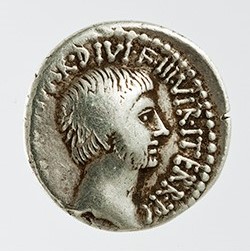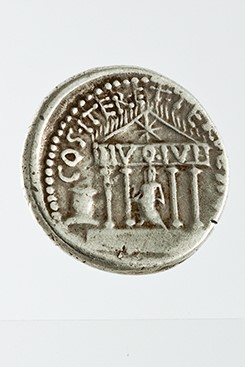Acquisition number: 1985.10
Obv.: Bare head of Octavian, r., bearded. IMP. CAESAR DIVI F(ilius) IIIVIR ITER R(ei) P(ublicae) C(onstituendae).
Rev.: Tetrastyle temple; within, statue of veiled figure holding lituus (augur’s staff) in right hand; on architrave, DIVO IVL(io); within pediment, star. To left of temple, lighted altar. COS. ITER ET TER DESIG(natus).
Title: Denarius of Octavian - 1985.10
Acquisition number: 1985.10
Author or editor: Beryl Rawson
Culture or period: Roman Republic
Date: 36 BC
Material: Metal - Silver
Object type: Coins - Roman
Dimensions: 18mm (w)
Origin region or location: Tunisia
Origin city: Mint moving with Octavian
Display case or on loan: 5
Keywords: Coin, denarius, Roman, Republic, Octavian, Augustus, Roman Africa
Sear, D.R., Roman Coins and their Values 5 vols (London, Spink, 2000-2014) 1545; Crawford, M., Roman Republican Coinage 2 vols (Cambridge, Cambridge University Press, 2011) 540/2; Sear, D.R., The History and Coinage of the Roman Imperators (London, Spink, 1998) 315; Grueber, H.A., Coins of the Roman Republic in the British Museum 3 vols (London, The Trustees of the British Museum, 1910; rev. edn London, 1970) Africa 33; Seaby, H.A., Roman Silver Coins (London, B.A. Seaby, 1967) 90 (Italy spring-summer 36 BC); Sydenham, E. A. The Coinage of the Roman Republic (London, Spink, 1952; (Sanford J. Durst repr. 1976) 1338.
1985.10
Denarius of Octavian
3.89 g. 36 BC (mint moving with Octavian)
Obv.: Bare head of Octavian, r., bearded. IMP. CAESAR DIVI F(ilius) IIIVIR ITER R(ei) P(ublicae) C(onstituendae).
Rev.: Tetrastyle temple; within, statue of veiled figure holding lituus (augur’s staff) in right hand; on architrave, DIVO IVL(io); within pediment, star. To left of temple, lighted altar. COS. ITER ET TER DESIG(natus).
The only portrait on this coin is that of Octavian, and from 37 BC the only name on his coinage was his own. (Cf. earlier coins of Triumvirate from 43 BC.) Antony no longer appears, as the relationship between the two deteriorated again after 40 BC. These aspects, plus Octavian’s titles and his advertised connection with the deified Julius Caesar, distinguish Octavian’s coinage of the 30s BC from that of Antony. As Crawford writes (II. 744), ‘There could be no clearer indication of the arrival of autocracy’.
On the obverse Octavian is imp(erator) in recognition of military victories, a title used since the victory at Philippi in 44 BC he uses the adoptive name of ‘Caesar’ as son of the deified Julius Caesar (diui f(ilius)), and commemorates his appointment to a second term (iter(um)) as triumvir from 38 BC. The titles round the edge of the reverse record Octavian’s election to a second consulship (held in 33 BC) and to a third (31 BC), which were decided well in advance of the years of office (desig(natus)), perhaps in anticipation of the expiry of his triumviral powers at the end of the second five-year term.
The beard on Octavian’s face helps date the coin to no later than 36 BC. He wore it as a sign of mourning for Julius Caesar from 44 BC and shaved it off after Naulochus in 36 BC.
Octavian was busy campaigning in Sicily (against Sextus Pompeius) in 36 BC joined by Lepidus from Africa. After the defeat of Sextus Pompeius at Naulochus, Octavian deprived Lepidus of his triumviral powers and his province of Africa. Octavian took responsibility for Africa, and the fabric of this coin suggests that it was minted in Africa, probably as part of an issue to reward Octavian's troops.
Octavian's connection with the deified Julius Caesar is further emphasised by the image of the temple for Caesar (with DIVO IVL(io), ‘for the deified Julius’, inscribed on the architrave of the temple), whose building in the Forum had probably already begun. Within the pediment is the star (sidus Iulium) signifying Julius Caesar’s transition to the home of the gods, and the lighted altar on the left is part of the ritual of sacrifice and worship associated with gods. The veiled figure inside the temple is probably Julius Caesar: in his right hand he holds the lituus, the staff which was the symbol of the Roman augur, a religious position held by Caesar from c. 47 BC to his death in 44 BC. Octavian had been augur since 42 BC, hence his identity with Julius Caesar is here underlined. On the Julian star, cf. 68.13 (44 BC) and see S. Weinstock, Divus Julius (Oxford 1971) 377-8.
Sear, D.R., Roman Coins and their Values 5 vols (London, Spink, 2000-2014) 1545; Crawford, M., Roman Republican Coinage 2 vols (Cambridge, Cambridge University Press, 2011) 540/2; Sear, D.R., The History and Coinage of the Roman Imperators (London, Spink, 1998) 315; Grueber, H.A., Coins of the Roman Republic in the British Museum 3 vols (London, The Trustees of the British Museum, 1910; rev. edn London, 1970) Africa 33; Seaby, H.A., Roman Silver Coins (London, B.A. Seaby, 1967) 90 (Italy spring-summer 36 BC); Sydenham, E. A. The Coinage of the Roman Republic (London, Spink, 1952; (Sanford J. Durst repr. 1976) 1338.

